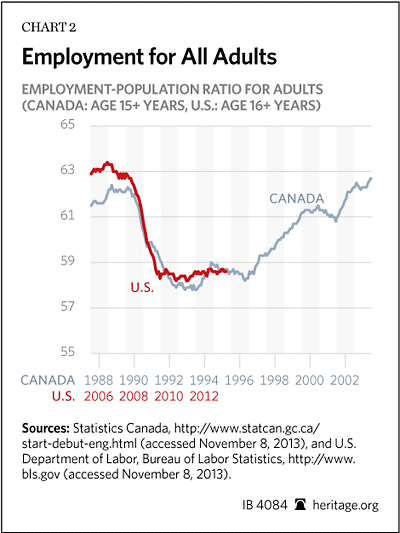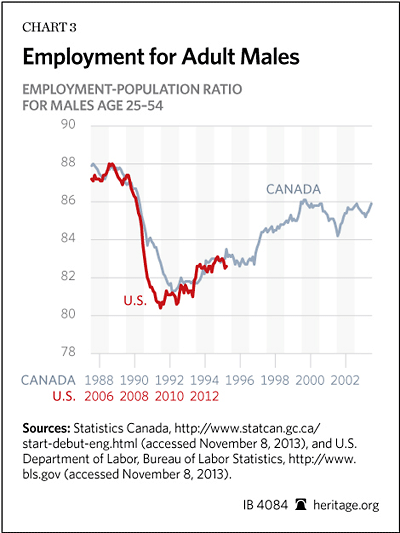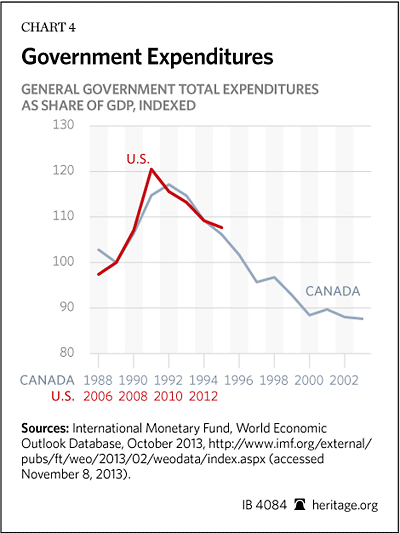The economy created 204,000 jobs in October, although labor force participation dropped to its lowest level in 35 years and unemployment ticked up to 7.3 percent. The labor market remained mediocre despite a monthly payroll survey that showed “no discernible impacts of the partial federal government shutdown on the estimates of employment, hours, and earnings.”
The U.S. is mired in an economic slump: Although the economy is growing, many are not contributing to or benefiting from the mediocre growth. U.S. policymakers might be able to learn from Canada’s 1990s similar slump and subsequent recovery.
October Employment Report
The payroll survey reports that employers added 204,000 net new jobs in October, exceeding expectations. Revisions to the prior jobs report were positive, with 60,000 additional jobs added.
Employment grew the most in the leisure and hospitality (+53,000), retail trade (+44,000), professional and technical services (+21,000), and manufacturing (+19,000) sectors. Employment fell slightly in the government (–8,000) and wholesale trade (–5,400) sectors.
Today’s report and the new gross domestic product (GDP) growth estimate of 2.8 percent for the third quarter indicate that labor demand is recovering. However, labor supply continues to weaken. Higher labor taxes, extended welfare benefits, and Obamacare may be depressing individual labor supply, as we discuss at length in a recent paper.[1]
The household survey shows a huge drop in labor force participation to 62.8 percent from 63.2 percent. Labor force participation has not been this low since 1978. The headline unemployment rate rose to 7.3 percent and the number of unemployed rose slightly. The government shutdown showed up in the household survey data, with 448,000 more on “temporary layoff” than in September, including many furloughed government workers who have since returned to work.
Canada’s 1990s and the U.S.’s 2010s: Studies in Slumps
A severe recession hit Canada in 1990. GDP fell more than 3 percent below its peak, and employment dropped below 60 percent of the adult population in early 1991. Then GDP stabilized and began a slow recovery, but employment kept falling. Employment fell through 1991 and 1992, bottoming out at 58 percent. Then, it stayed put. Seven years after the recession began, employment still hadn’t recovered past 59 percent.
Meanwhile, Canada’s government spending had drifted up past 50 percent of GDP, and in 1995, gross public debt exceeded GDP for the first time.
To Americans who have lived through the recession and slump since 2008, this all sounds eerily familiar. David Andolfatto, an economist at the Federal Reserve Bank of St. Louis, warned in 2010 that the U.S. could follow in Canada’s slumping footsteps[2] and recently observed an uncanny resemblance between the records through mid-2013.[3] For this Issue Brief, we replicated some of Andolfatto’s charts and added a few more.





The slump story has a happy ending: Canada’s economy started creating jobs, and the debt ratio began to decline again. The most obvious reason for Canada’s success in the late 1990s is that there was a huge tech boom next door in the U.S. Canada’s economy was seriously lagging the U.S. in employment throughout the 1990s, but when the U.S. economy cooled off in the 2000s, Canada’s surged past.
Thus, U.S. observers should look to policy changes in Canada around 1995.
Niels Veldhuis, Jason Clemens, and Milagros Palacios of the Fraser Institute describe a nation at the crossroads on January 12, 1995: “An editorial in the Wall Street Journal that commented on Canada’s debt problem and suggested the country was nearing bankruptcy caused a sharp decline in the value of the Canadian dollar.”[4]
The government proposed radical reforms in its 1995 budget: spending cuts of 8.8 percent in two years and reducing federal employment by 14 percent. Veldhuis, Clemens, and Palacios record that “the government not only achieved its plan but exceeded it. Over two years…the federal government reduced program spending by…9.7 percent. Again, this was not a slowing of growth in spending over time but rather a reduction in the amount of spending.”[5]
Canada’s cuts show that major cuts can be enacted well. Its cuts were several times larger than the U.S.’s recent sequestration, but they spared the most efficient and important functions of government. “Unlike other governments that have tackled deficits by cutting spending across the board, the federal government relied on a methodical approach aimed at prioritizing spending.”[6] Deep cuts can be made with finesse.
Some of the deepest cuts that Canada undertook are reminiscent of wasteful and harmful government spending in the U.S. As in the U.S.,[7] distorting subsidies to agriculture were ripe for reform, and the budget cut federal support of agricultural safety nets by 30 percent and milk subsidies by 30 percent, and it ended the Feed Freight Assistance transportation subsidy.[8] Subsidies to other big businesses were cut by more than half.
Canada did not stop there. Labor market reforms to “make work pay” were introduced in the 1990s as well. In 1996, the unemployment insurance system was overhauled, with “a shift in focus from passive income support to more active labour market interventions aimed at helping people find and keep jobs.”[9] Canada’s provinces signed the 1995 Agreement on Internal Trade to reduce barriers to trade and labor movement.
The 1995 budget got deficits under control, turned the growing debt into a shrinking debt, and put Canada in a position to take advantage of the late-‘90s boom. One cautionary note is that despite balanced budgets and a booming economy, it still took a decade to bring the debt-to-GDP ratio back to where it had been in 1989. Debt is easy to add and hard to subtract. Another lesson is that Canadian policymakers were not daunted by slow GDP growth in 1995; after all, government spending is a component of GDP, so spending cuts mechanically lower GDP. If Canadian policymakers had been focused on boosting GDP in the next quarter, they would not have made those bold and necessary cuts.
Look North
Canada’s experience with a severe recession and jobless recovery from 1990 to 1995 can be instructive to the U.S. Canada’s government broke out of the crisis by rebuilding its unemployment insurance system, cutting federal spending by 9.7 percent, and shrinking the federal workforce by 14 percent. The result was a rapid return to growth. Canada overcame the large gap in labor force participation relative to the U.S.
Now, the U.S. is lagging far behind Canada in employment and labor force participation. U.S. spending and debt are well above their pre-2008 relative levels, and tax increases are stifling the labor market.
U.S. policymakers should learn from Canada’s example, which was exceptionally well executed. What is not exceptional is growth following spending cuts: As the economic literature shows, spending cuts are far more effective than tax increases at reducing deficits and allowing growth.[10] If the U.S. wants to see its economic indicators heading north again, it should follow the Canadian model with labor reforms and decisive reductions in government spending.
—Salim Furth, PhD, is Senior Policy Analyst in Macroeconomics and James Sherk is Senior Policy Analyst in Labor Economics in the Center for Data Analysis at The Heritage Foundation. Filip Jolevski is currently a member of the Young Leaders Program at The Heritage Foundation.


